Effect of Pulsed Current on the Tensile Deformation Behavior and Microstructure Evolution of AZ80 Magnesium Alloy
Abstract
1. Introduction
2. Materials and Methods
3. Results and Discussion
3.1. Deformation Behavior
3.2. Microstructure Evolution under Different Deformation Conditions
4. Conclusions
- (1)
- Compared to the tensile tests at RT and GT, when pulsed current is applied to the sample during tensile deformation, the flow stress decreases, which is caused by both the thermal and athermal effects.
- (2)
- Thermal and athermal effects annihilate the dislocations produced during tensile deformation. At the same strain, the GND density of the PC sample is the lowest, which leads to the reduction of flow stress. Meanwhile, pulsed current can slow down the dislocation piling up and can alleviate the concentration of local stress in GBs.
- (3)
- Through annihilating dislocations and alleviating the concentration of local stress, pulsed current inhibits {10−12} tension twin activation.
Author Contributions
Funding
Conflicts of Interest
References
- Joost, W.J.; Krajewski, P.E. Towards magnesium alloys for high-volume automotive applications. Scr. Mater. 2017, 128, 107–112. [Google Scholar] [CrossRef]
- Joost, W.J. Reducing Vehicle Weight and Improving U.S. Energy Efficiency Using Integrated Computational Materials Engineering. JOM 2012, 64, 1032–1038. [Google Scholar] [CrossRef]
- Mordike, B.L.; Ebert, T. Magnesium: Properties—Application—potential. Mater. Sci. Eng. A 2001, 302, 37–45. [Google Scholar] [CrossRef]
- Friedrich, H.; Schumann, S. Research for a “new age of magnesium” in the automotive industry. J. Mater. Process. Technol. 2001, 117, 276–281. [Google Scholar] [CrossRef]
- Wu, Y.; Liu, J.; Deng, B.; Ye, T.; Li, Q.; Zhou, X.; Zhang, H. Microstructure, Texture and Mechanical Properties of AZ31 Magnesium Alloy Fabricated by High Strain Rate Biaxial Forging. Materials 2020, 13, 3050. [Google Scholar] [CrossRef]
- El Mehtedi, M.; D’Orazio, A.; Forcellese, A.; Pieralisi, M.; Simoncini, M. Effect of the rolling temperature on hot formability of ZAM100 magnesium alloy. In Procedia CIRP 2018; Teti, R., Daddona, D.M., Eds.; Elsevier: Naples, Italy, 2017; p. 493. ISSN 22128–271. [Google Scholar]
- Zhang, S.; Tang, G.H.; Wang, W.; Jiang, X. Evaluation and optimization on the formability of an AZ31B Mg alloy during warm incremental sheet forming assisted with oil bath heating. Measurement 2020, 157, 107673. [Google Scholar] [CrossRef]
- Ambrogio, G.; Filice, L.; Gagliardi, F. Formability of lightweight alloys by hot incremental sheet forming. Mater. Des. 2012, 34, 501–508. [Google Scholar] [CrossRef]
- Influence of the chemical composition of Al/AlC/a-C:H coatings on the mechanical properties of magnesium alloy AZ31. Met. Sci. Heat Treat. 2018, 60, 443–449. [CrossRef]
- Liu, X.; Yang, Q.; Li, Z.; Yuan, W.; Zheng, Y.; Cui, Z.; Yang, X.; Yeung, K.W.K.; Wu, S. A combined coating strategy based on atomic layer deposition for enhancement of corrosion resistance of AZ31 magnesium alloy. Appl. Surf. Sci. 2018, 434, 1101–1111. [Google Scholar] [CrossRef]
- Gennari, C.; Pezzato, L.; Simonetto, E.; Gobbo, R.; Forzan, M.; Calliari, I. Investigation of Electroplastic Effect on Four Grades of Duplex Stainless Steels. Materials 2019, 12, 1911. [Google Scholar] [CrossRef]
- Conrad, H. Electroplasticity in metals and ceramics. Mater. Sci. Eng. A 2000, 287, 276–287. [Google Scholar] [CrossRef]
- Xu, Z.S.; Lai, Z.H.; Chen, Y.X. Effect of electric current on the recrystallization behavior of cold worked α-Ti. Scr. Metal. Mater. 1988, 22, 187–190. [Google Scholar] [CrossRef]
- Conrad, H. Thermally activated plastic flow of metals and ceramics with an electric field or current. Mater. Sci. Eng. A 2002, 322, 100–107. [Google Scholar] [CrossRef]
- Conrad, H.; Cao, W.D.; Lu, X.P.; Sprecher, A.F. Effect of an electric field on the superplasticity of 7475 Al. Scr. Metal. Mater. 1989, 23, 697–702. [Google Scholar] [CrossRef]
- Lu, X.P.; Cao, W.D.; Sprecher, A.F.; Conrad, H. Influence of an external electric field on the microstructure of superplastically deformed 7475 Al. J. Mater. Sci. 1992, 27, 2243–2250. [Google Scholar] [CrossRef]
- Magargee, J.; Morestin, F.; Cao, J. Characterization of Flow Stress for Commercially Pure Titanium Subjected to Electrically Assisted Deformation. J. Eng. Mater. Technol. 2013, 135, 41003. [Google Scholar] [CrossRef]
- Li, C.; Jiang, S.; Zhang, K. Pulse current-assisted hot-forming of light metal alloy. Int. J. Adv. Manuf. Technol. 2012, 63, 931–938. [Google Scholar] [CrossRef]
- Kuang, J.; Du, X.; Li, X.; Yang, Y.; Luo, A.A.; Tang, G. Athermal influence of pulsed electric current on the twinning behavior of Mg-3Al-1Zn alloy during rolling. Scr. Mater. 2016, 114, 151–155. [Google Scholar] [CrossRef]
- Kim, M.J.; Lee, K.; Oh, K.H.; Choi, I.S.; Yu, H.-H.; Hong, S.T.; Han, H.N. Electric current-induced annealing during uniaxial tension of aluminum alloy. Scr. Mater. 2014, 75, 58–61. [Google Scholar] [CrossRef]
- Jeong, H.J.; Kim, M.-J.; Park, J.W.; Yim, C.D.; Kim, J.J.; Kwon, O.D.; Madakashira, P.P.; Han, H.N. Effect of pulsed electric current on dissolution of Mg17Al12 phases in as-extruded AZ91 magnesium alloy. Mater. Sci. Eng. A 2017, 684, 668–676. [Google Scholar] [CrossRef]
- Song, G.L.; Atrens, A. Corrosion mechanisms of magnesium alloys. Adv. Eng. Mater. 1999, 1, 11–33. [Google Scholar] [CrossRef]
- Wang, P.Y.; Wang, B.Y.; Wang, C.; Wang, J.G.; Ma, C.Y.; Li, J.S.; Zha, M.; Wang, H.Y. Design of multicomponent Mg-Al-Zn-Sn-Bi alloys with refined microstructure and enhanced tensile properties. Mater. Sci. Eng. A 2020, 791, 139696. [Google Scholar] [CrossRef]
- Wang, X.Y.; Wang, Y.F.; Wang, C.; Xu, S.; Rong, J.; Yang, Z.Z.; Wang, J.G.; Wang, H.Y. A simultaneous improvement of both strength and ductility by Sn addition in as-extruded Mg-6Al-4Zn alloy. J. Mater. Sci. Technol. 2020, 49, 117–125. [Google Scholar] [CrossRef]
- Huo, Q.; Xiao, Z.; Yang, X.; Ando, D.; Sutou, Y.; Koike, J. Enhanced fatigue properties of cast AZ80 Mg alloy processed by cyclic torsion and low-temperature annealing. Mater. Sci. Eng. A 2017, 696, 52–59. [Google Scholar] [CrossRef]
- Qin, D.H.; Wang, M.J.; Sun, C.Y.; Su, Z.X.; Qian, L.Y.; Sun, Z.H. Interaction between texture evolution and dynamic recrystallization of extruded AZ80 magnesium alloy during hot deformation. Mater. Sci. Eng. A 2020, 788, 139537. [Google Scholar] [CrossRef]
- Ma, X.; Huang, C.; Moering, J.; Ruppert, M.; Hoeppel, H.W.; Goeken, M.; Narayan, J.; Zhu, Y. Mechanical properties of copper/bronze laminates: Role of interfaces. Acta Mater. 2016, 116, 43–52. [Google Scholar] [CrossRef]
- Gao, H.; Huang, Y.; Nix, W.D.; Hutchinson, J.W. Mechanism-based strain gradient plasticity—I. Theory J. Mech. Phys. Solids 1999, 47, 1239–1263. [Google Scholar] [CrossRef]
- Nie, J.F. Effects of precipitate shape and orientation on dispersion strengthening in magnesium alloys. Scr. Mater. 2003, 48, 1009–1015. [Google Scholar] [CrossRef]
- Andre, D.; Burlet, T.; Körkemeyer, F.; Gerstein, G.; Gibson, J.S.K.L.; Sandlöbes-Haut, S.; Korte-Kerzel, S. Investigation of the electroplastic effect using nanoindentation. Mater. Des. 2019, 183, 108153. [Google Scholar] [CrossRef]
- Hu, G.; Zhu, Y.; Tang, G.; Shek, C.; Liu, J. Effect of Electropulsing on Recrystallization and Mechanical Properties of Silicon Steel Strips. J. Mater. Sci. Technol. 2011, 27, 1034–1038. [Google Scholar] [CrossRef]
- Kubin, L.P.; Mortensen, A. Geometrically necessary dislocations and strain-gradient plasticity: A few critical issues. Scr. Mater. 2003, 48, 119–125. [Google Scholar] [CrossRef]
- Chapuis, A.; Driver, J.H. Temperature dependency of slip and twinning in plane strain compressed magnesium single crystals. Acta Mater. 2011, 59, 1986–1994. [Google Scholar] [CrossRef]
- Lee, S.W.; Kim, S.H.; Jo, W.K.; Hong, W.H.; Kim, W.; Moon, B.G.; Park, S.H. Twinning and slip behaviors and microstructural evolutions of extruded Mg-1Gd alloy with rare-earth texture during tensile deformation. J. Alloys Compd. 2019, 791, 700–710. [Google Scholar] [CrossRef]
- Mu, S.; Jonas, J.J.; Gottstein, G. Variant selection of primary, secondary and tertiary twins in a deformed Mg alloy. Acta Mater. 2012, 60, 2043–2053. [Google Scholar] [CrossRef]
- Jonas, J.J.; Mu, S.; Al-Samman, T.; Gottstein, G.; Jiang, L.; Martin, Ė. The role of strain accommodation during the variant selection of primary twins in magnesium. Acta Mater. 2011, 59, 2046–2056. [Google Scholar] [CrossRef]
- Lou, C.; Zhang, X.; Ren, Y. Non-Schmid-based {101–2} twinning behavior in polycrystalline magnesium alloy. Mater. Charact. 2015, 107, 249–254. [Google Scholar] [CrossRef]
- Xu, S.; Toth, L.S.; Schuman, C.; Lecomte, J.-S.; Barnett, M.R. Dislocation mediated variant selection for secondary twinning in compression of pure titanium. Acta Mater. 2017, 124, 59–70. [Google Scholar] [CrossRef]
- Yang, Y.; Qin, Q.; Zhang, Z.; Wang, Q.; Meng, M.; Liang, M.-j.; Hu, H. Processing maps of extruded AZ80 + 0.4% Ce magnesium alloy. J. Alloys Compd. 2020, 844, 156064. [Google Scholar] [CrossRef]
- Koike, J.; Sato, Y.; Ando, D. Origin of the Anomalous {10over-bar2} Twinning during Tensile Deformation of Mg Alloy Sheet. Mater. Trans. 2008, 49, 2792–2800. [Google Scholar] [CrossRef]
- Imandoust, A.; Barrett, C.D.; El Kadiri, H. Effect of rare earth addition on {1012} twinning induced hardening in magnesium. Mater. Sci. Eng. A 2018, 720, 225–230. [Google Scholar] [CrossRef]
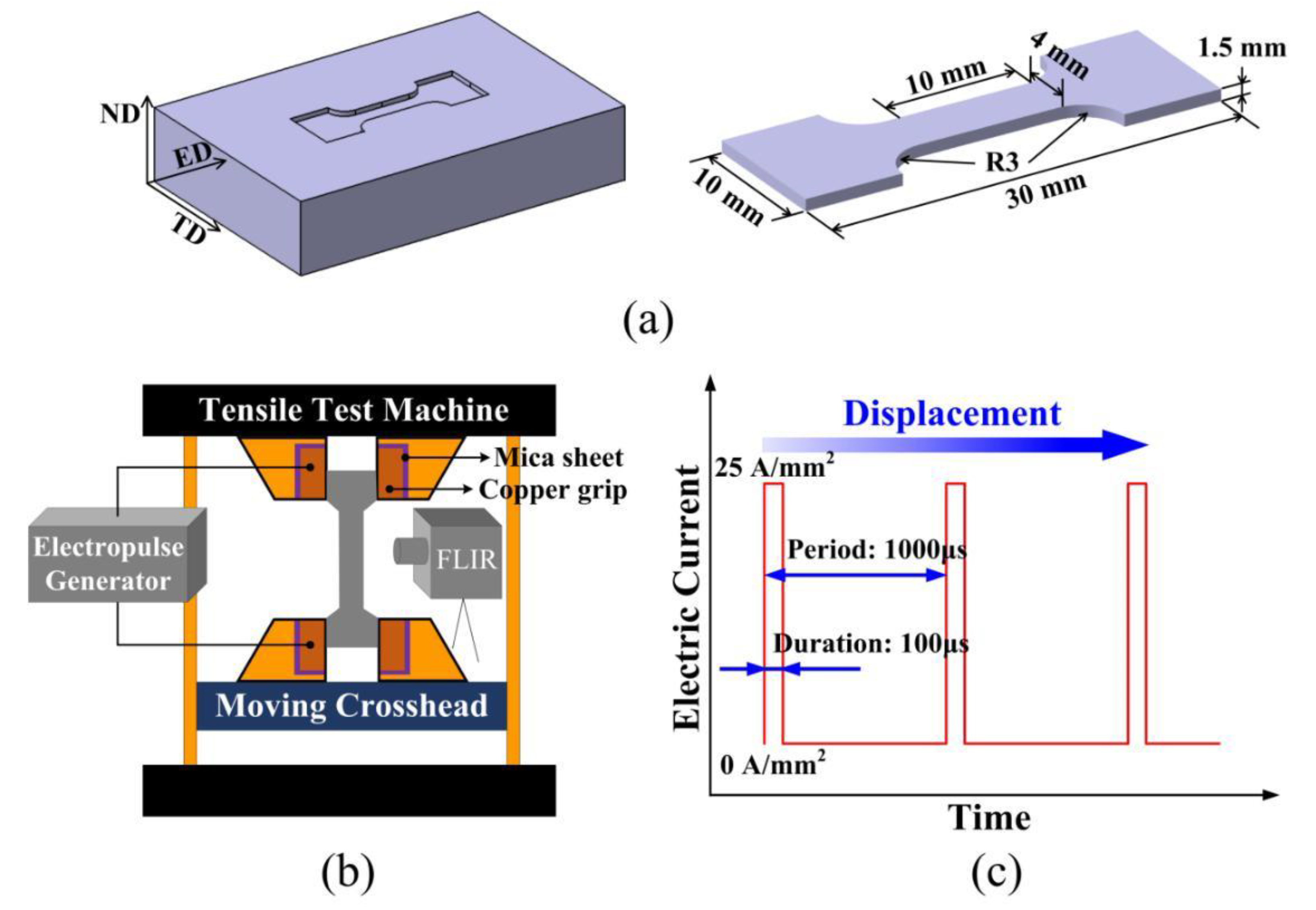
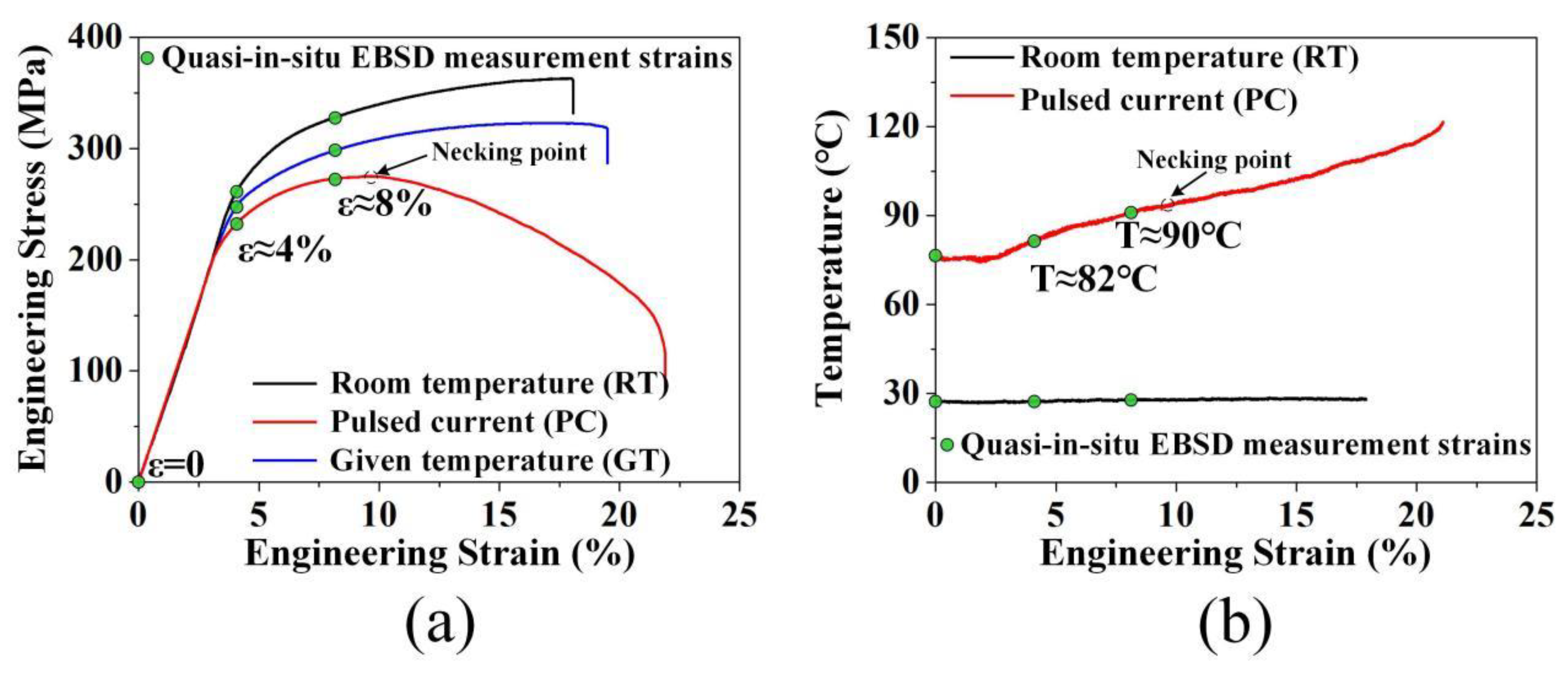
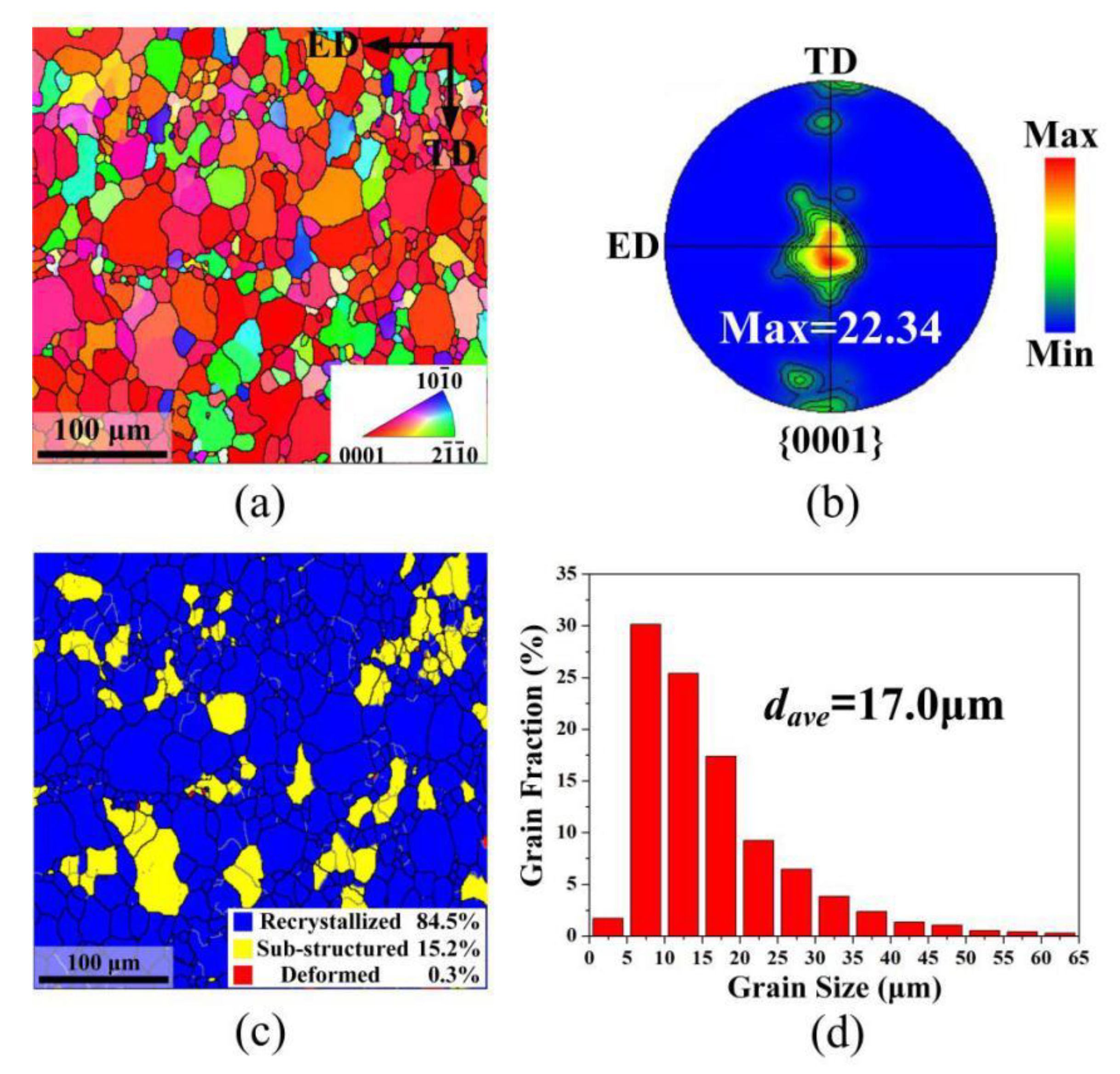
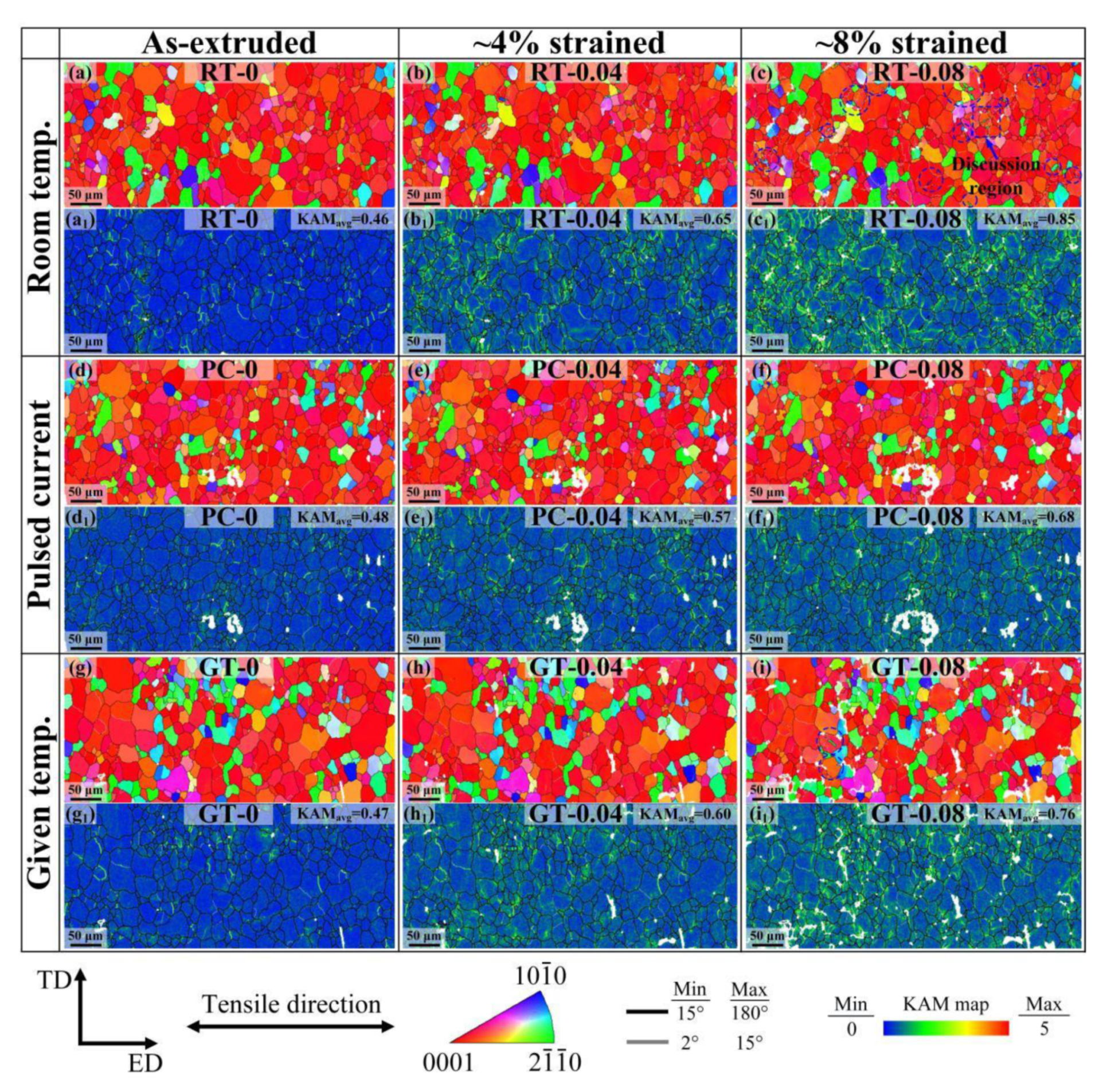
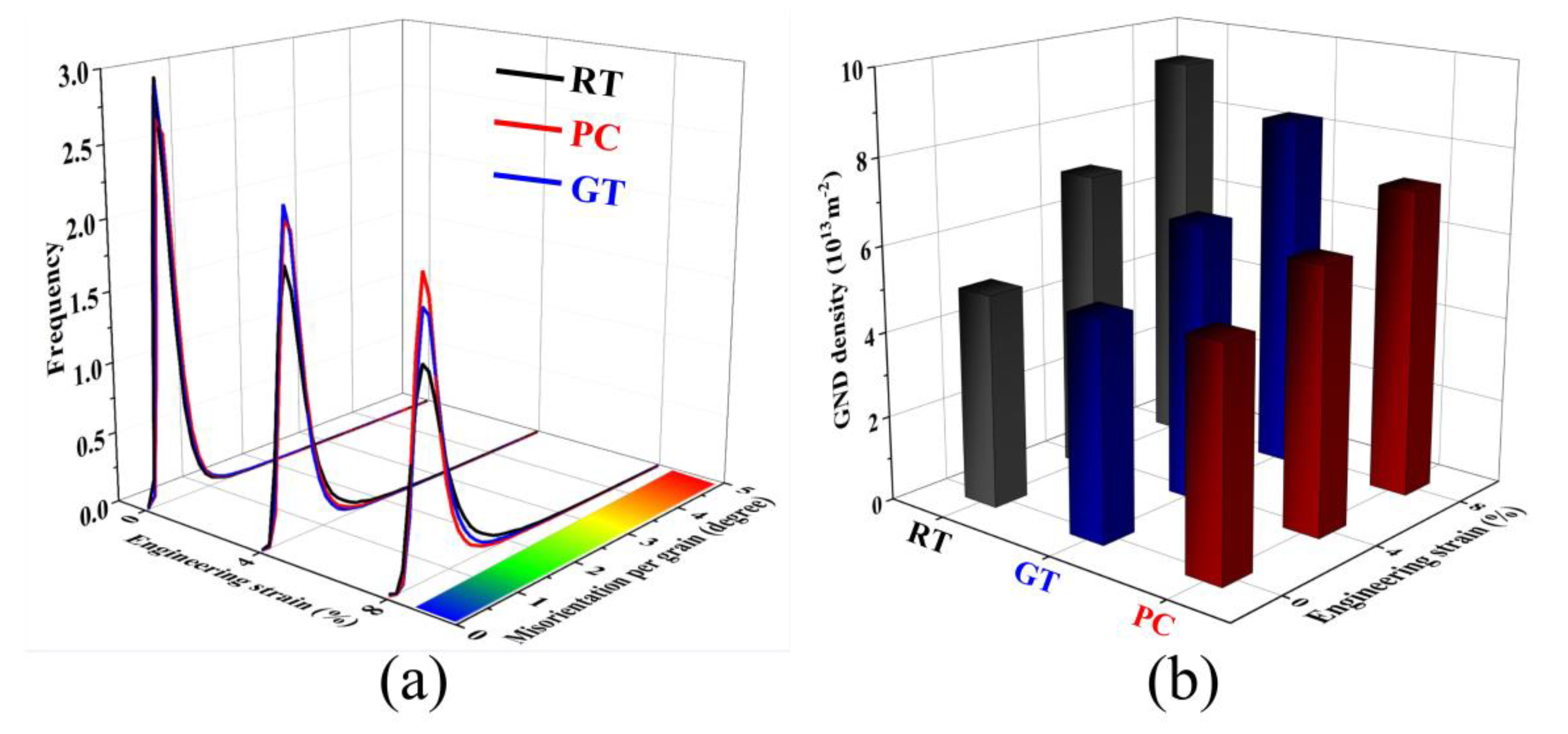

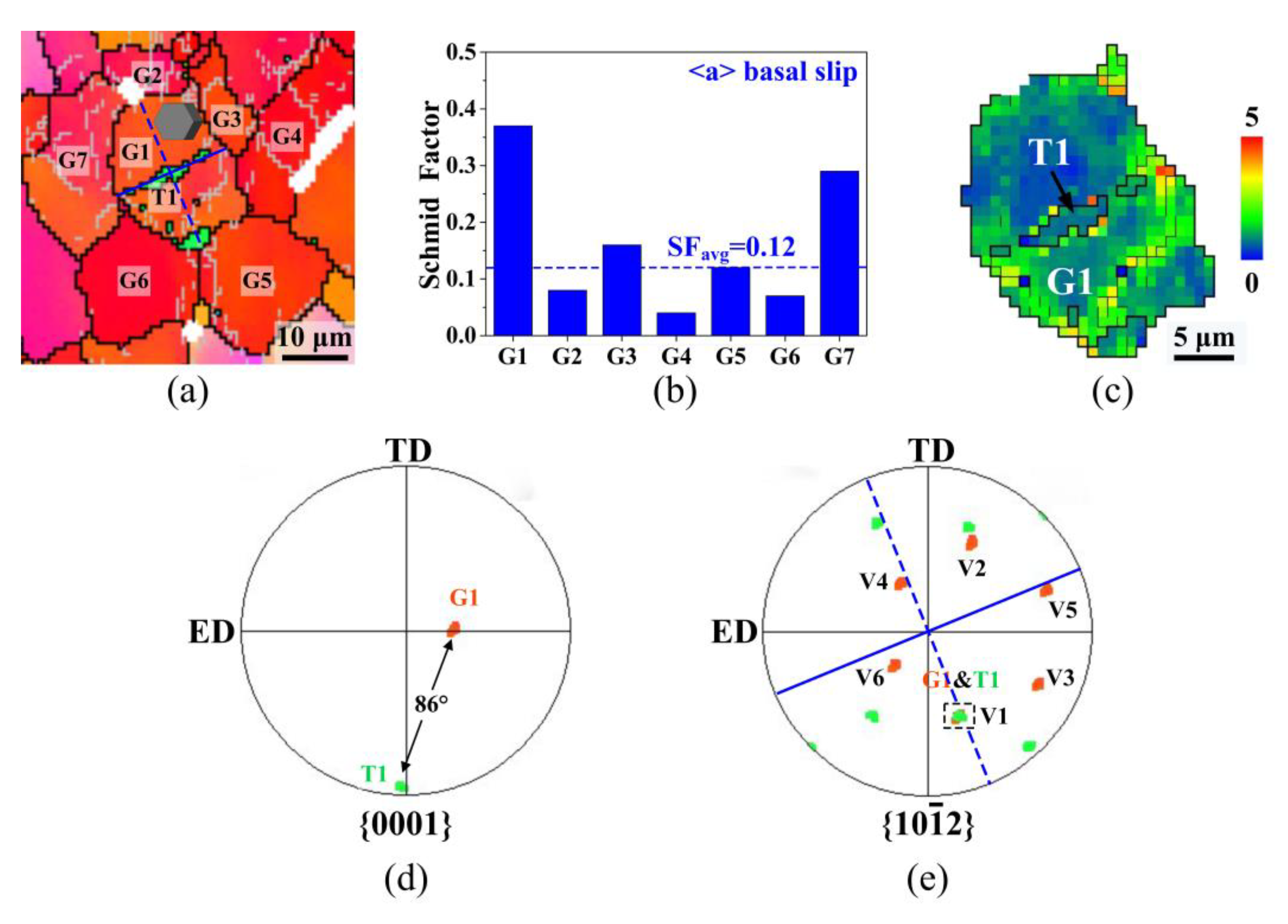
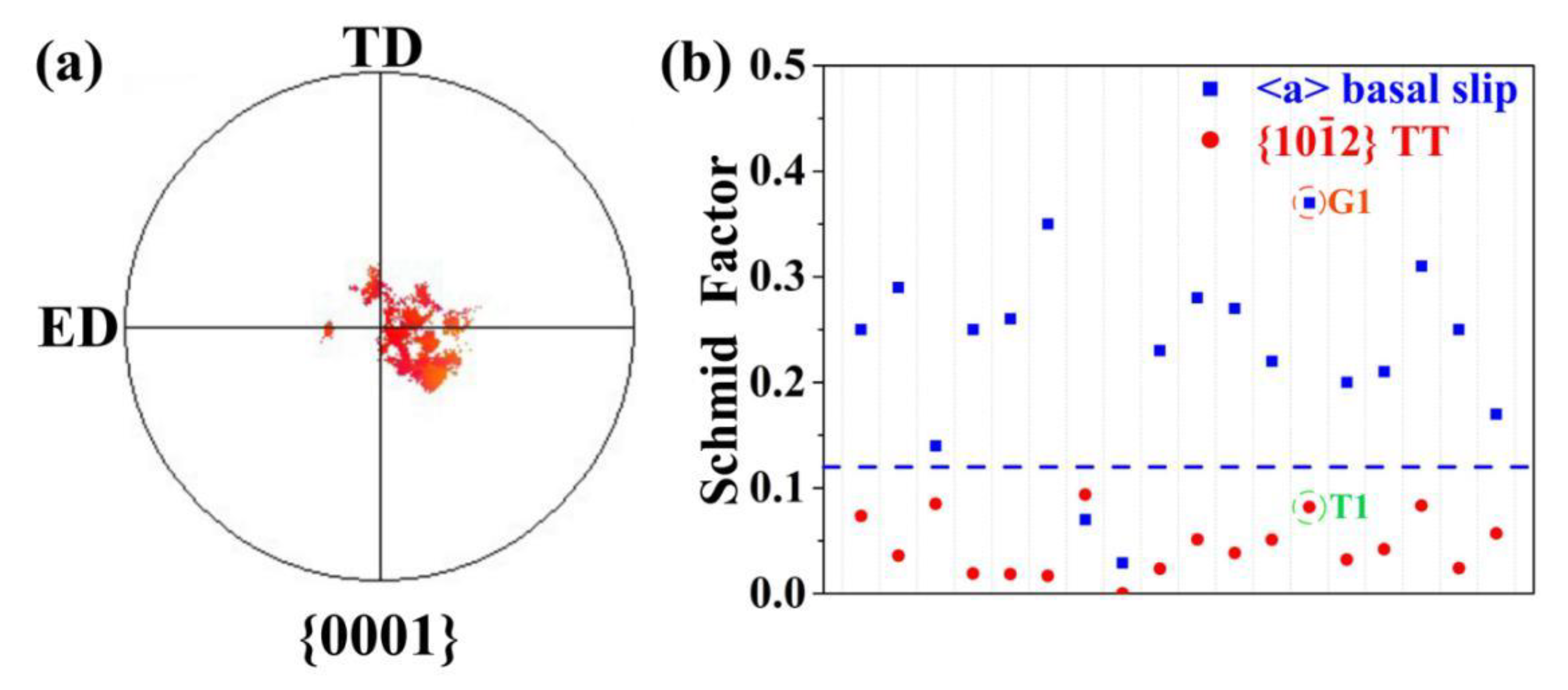
| ε = 0 | ε = 0.04 | ε = 0.08 | |
|---|---|---|---|
| Room Temperature (RT) | RT-0 | RT-0.04 | RT-0.08 |
| Pulsed Current (PC) | PC-0 | PC-0.04 | PC-0.08 |
| Given Temperature (GT) | GT-0 | GT-0.04 | GT-0.08 |
| Yield Strength (MPa) | Ultimate Strength (MPa) | |
|---|---|---|
| Room Temperature (RT) | 273.1 ± 0.7 | 363.6 ± 2.5 |
| Pulsed Current (PC) | 214.7 ± 0.3 | 272.6 ± 1.8 |
| Given Temperature (GT) | 236.7 ± 0.6 | 324.5 ± 2.1 |
| G1 (Euler Angle: 93.0°, 24.2°, 52.6°) | |||
|---|---|---|---|
| Twin Variants | Twining System | Misorientation (θ) | Schmid Factor |
| V1 | (−1102)[1−101] | 1.8 | 0.082 |
| V2 | (1−102)[−1101] | 86.4 | 0.078 |
| V3 | (−1012)[10−11] | 39.5 | −0.221 |
| V4 | (10−12)[−1011] | 73.2 | −0.181 |
| V5 | (0−112)[01−11] | 72.7 | −0.274 |
| V6 | (01−12)[0−111] | 39.8 | −0.231 |
Publisher’s Note: MDPI stays neutral with regard to jurisdictional claims in published maps and institutional affiliations. |
© 2020 by the authors. Licensee MDPI, Basel, Switzerland. This article is an open access article distributed under the terms and conditions of the Creative Commons Attribution (CC BY) license (http://creativecommons.org/licenses/by/4.0/).
Share and Cite
Xu, H.; Zhou, Y.; Zou, Y.-J.; Liu, M.; Guo, Z.-P.; Ren, S.-Y.; Yan, R.-H.; Cheng, X.-M. Effect of Pulsed Current on the Tensile Deformation Behavior and Microstructure Evolution of AZ80 Magnesium Alloy. Materials 2020, 13, 4840. https://doi.org/10.3390/ma13214840
Xu H, Zhou Y, Zou Y-J, Liu M, Guo Z-P, Ren S-Y, Yan R-H, Cheng X-M. Effect of Pulsed Current on the Tensile Deformation Behavior and Microstructure Evolution of AZ80 Magnesium Alloy. Materials. 2020; 13(21):4840. https://doi.org/10.3390/ma13214840
Chicago/Turabian StyleXu, Hong, You Zhou, Yu-Jie Zou, Meng Liu, Zhi-Peng Guo, Si-Yu Ren, Rong-Hui Yan, and Xiu-Ming Cheng. 2020. "Effect of Pulsed Current on the Tensile Deformation Behavior and Microstructure Evolution of AZ80 Magnesium Alloy" Materials 13, no. 21: 4840. https://doi.org/10.3390/ma13214840
APA StyleXu, H., Zhou, Y., Zou, Y.-J., Liu, M., Guo, Z.-P., Ren, S.-Y., Yan, R.-H., & Cheng, X.-M. (2020). Effect of Pulsed Current on the Tensile Deformation Behavior and Microstructure Evolution of AZ80 Magnesium Alloy. Materials, 13(21), 4840. https://doi.org/10.3390/ma13214840




